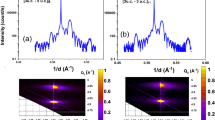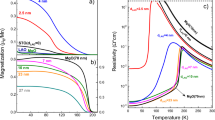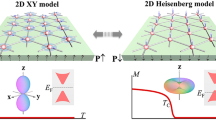Abstract
Controlled in-plane rotation of the magnetic easy axis in manganite heterostructures by tailoring the interface oxygen network could allow the development of correlated oxide-based magnetic tunnelling junctions with non-collinear magnetization, with possible practical applications as miniaturized high-switching-speed magnetic random access memory (MRAM) devices. Here, we demonstrate how to manipulate magnetic and electronic anisotropic properties in manganite heterostructures by engineering the oxygen network on the unit-cell level. The strong oxygen octahedral coupling is found to transfer the octahedral rotation, present in the NdGaO3 (NGO) substrate, to the La2/3Sr1/3MnO3 (LSMO) film in the interface region. This causes an unexpected realignment of the magnetic easy axis along the short axis of the LSMO unit cell as well as the presence of a giant anisotropic transport in these ultrathin LSMO films. As a result we possess control of the lateral magnetic and electronic anisotropies by atomic-scale design of the oxygen octahedral rotation.
This is a preview of subscription content, access via your institution
Access options
Subscribe to this journal
Receive 12 print issues and online access
$259.00 per year
only $21.58 per issue
Buy this article
- Purchase on Springer Link
- Instant access to full article PDF
Prices may be subject to local taxes which are calculated during checkout





Similar content being viewed by others
References
Hwang, H. Y. et al. Emergent phenomena at oxide interfaces. Nature Mater. 11, 103–113 (2012).
Zubko, P., Gariglio, S., Gabay, M., Ghosez, P. & Triscone, J.-M. Interface physics in complex oxide heterostructures. Annu. Rev. Condens. Matter Phys. 2, 141–165 (2011).
Chakhalian, J. et al. Orbital reconstruction and covalent bonding at an oxide interface. Science 318, 1114–1117 (2007).
Ohtomo, A. & Hwang, H. Y. A high-mobility electron gas at the LaAlO3/SrTiO3 heterointerface. Nature 427, 423–426 (2004).
Brinkman, A. et al. Magnetic effects at the interface between non-magnetic oxides. Nature Mater. 6, 493–496 (2007).
Tokura, Y. & Nagaosa, N. Orbital physics in transition-metal oxides. Science 288, 462–468 (2000).
Dagotto, E. Complexity in strongly correlated electronic systems. Science 309, 257–262 (2005).
Aetukuri, N. B. et al. Control of the metal–insulator transition in vanadium dioxide by modifying orbital occupancy. Nature Phys. 9, 661–666 (2013).
Ward, T. Z. et al. Elastically driven anisotropic percolation in electronic phase-separated manganites. Nature Phys. 5, 885–888 (2009).
Schlom, D. G. et al. Strain tuning of ferroelectric thin films. Annu. Rev. Mater. Res. 37, 589–626 (2007).
Boris, A. V. et al. Dimensionality control of electronic phase transitions in nickel-oxide superlattices. Science 332, 937–940 (2011).
King, P. D. C. et al. Atomic-scale control of competing electronic phases in ultrathin LaNiO3 . Nature Nanotech. 9, 443–447 (2014).
Salamon, M. B. & Jaime, M. The physics of manganites: structure and transport. Rev. Mod. Phys. 73, 583–628 (2001).
Coey, J. M. D., Viret, M. & von Molnaír, S. Mixed-valence manganites. Adv. Phys. 48, 167–293 (1999).
Chmaissem, O. et al. Relationship between structural parameters and the Néel temperature in Sr1−xCaxMnO3 (0 < ∼ x < ∼ 1) and Sr1−yBayMnO3 (y < ∼ 0.2). Phys. Rev. B 64, 134412 (2001).
Radaelli, P. G. et al. Structural effects on the magnetic and transport properties of perovskite A1−xAx′MnO3 (x = 0.25, 0.30). Phys. Rev. B 56, 8265–8276 (1997).
Alonso, J. A., Martínez-Lope, M. J., Casais, M. T., Aranda, M. A. G. & Fernández-Díaz, M. T. Metal–insulator transitions, structural and microstructural evolution of RNiO3 (R = Sm, Eu, Gd, Dy, Ho, Y) perovskites: evidence for room-temperature charge disproportionation in monoclinic HoNiO3 and YNiO3 . J. Am. Chem. Soc. 121, 4754–4762 (1999).
Garcia-Munoz, J. L., Fontcuberta, J., Suaaidi, M. & Obradors, X. Bandwidth narrowing in bulk L2/3A1/3MnO3 magnetoresistive oxides. J. Phys. Condens. Matter 8, L787–L794 (1996).
Ding, Y. et al. Pressure-induced magnetic transition in manganite (La0.75Ca0.25MnO3). Phys. Rev. Lett. 102, 237201 (2009).
Zhai, X. F. et al. Correlating interfacial octahedral rotations with magnetism in (LaMnO3 + δ)N/(SrTiO3)N superlattices. Nature Commun. 5, 4283 (2014).
Rondinelli, J. M. & Spaldin, N. A. Structure and properties of functional oxide thin films: insights from electronic-structure calculations. Adv. Mater. 23, 3363–3381 (2011).
Lee, J. H. et al. Dynamic layer rearrangement during growth of layered oxide films by molecular beam epitaxy. Nature Mater. 13, 879–883 (2014).
Rondinelli, J. M., May, S. J. & Freeland, J. W. Control of octahedral connectivity in perovskite oxide heterostructures: an emerging route to multifunctional materials discovery. MRS Bull. 37, 261–270 (2012).
Kinyanjui, M. K. et al. Lattice distortions and octahedral rotations in epitaxially strained LaNiO3/LaAlO3 superlattices. Appl. Phys. Lett. 104, 221909 (2014).
Borisevich, A. Y. et al. Suppression of octahedral tilts and associated changes in electronic properties at epitaxial oxide heterostructure interfaces. Phys. Rev. Lett. 105, 087204 (2010).
He, J., Borisevich, A. Y., Kalinin, S. V., Pennycook, S. J. & Pantelides, S. T. Control of octahedral tilts and magnetic properties of perovskite oxide heterostructures by substrate symmetry. Phys. Rev. Lett. 105, 227203 (2010).
Aso, R., Kan, D., Shimakawa, Y. & Kurata, H. Atomic level observation of octahedral distortions at the perovskite oxide heterointerface. Sci. Rep. 3, 2214 (2013).
Chen, Y. B. et al. Interface structure and strain relaxation in BaTiO3 thin films grown on GdScO3 and DyScO3 substrates with buried coherent SrRuO3 layer. Appl. Phys. Lett. 91, 252906 (2007).
Glazer, A. M. Classification of tilted octahedral in perovskites. Acta Crystallogr. B 28, 3384–3392 (1972).
Vasylechko, L. et al. The crystal structure of NdGaO3 at 100 K and 293 K based on synchrotron data. J. Alloys Compd. 297, 46–52 (2000).
Liao, Z., Huijben, M., Koster, G. & Rijnders, G. Uniaxial magnetic anisotropy induced low field anomalous anisotropic magnetoresistance in manganite thin films. Appl. Phys. Lett. Mater. 2, 096112 (2014).
Ovsyannikov, S. V. et al. Perovskite-like Mn2O3: a path to new manganites. Angew. Chem. Int. Ed. 52, 1494–1498 (2013).
Boschker, H. et al. Strong uniaxial in-plane magnetic anisotropy of (001)- and (011)-oriented La0.67Sr0.33MnO3 thin films on NdGaO3 substrates. Phys. Rev. B 79, 214425 (2009).
Macke, S. et al. Element specific monolayer depth profiling. Adv. Mater. 26, 6554–6559 (2014).
Park, J. H. et al. Magnetic properties at surface boundary of a half-metallic ferromagnet La0.7Sr0.3MnO3 . Phys. Rev. Lett. 81, 1953–1956 (1998).
Huijben, M. et al. Critical thickness and orbital ordering in ultrathin La0.7Sr0.3MnO3 films. Phys. Rev. B 78, 094413 (2008).
Wang, B. M. et al. Oxygen-driven anisotropic transport in ultra-thin manganite films. Nature Commun. 4, 2778 (2013).
Vailionis, A. et al. Misfit strain accommodation in epitaxial ABO3 perovskites: lattice rotations and lattice modulations. Phys. Rev. B 83, 064101 (2011).
Medarde, M. et al. High-pressure neutron-diffraction study of the metallization process in PrNiO3 . Phys. Rev. B 52, 9248–9258 (1995).
Dong, S. et al. Highly anisotropic resistivities in the double-exchange model for strained manganites. Phys. Rev. B 82, 159902 (2010).
Brataas, A., Kent, A. D. & Ohno, H. Current-induced torques in magnetic materials. Nature Mater. 11, 372–381 (2012).
Brataasa, A., Bauer, G. E. W. & Kelly, P. J. Non-collinear magnetoelectronics. Phys. Rep. 427, 157–255 (2006).
Kan, D. et al. Tuning magnetic anisotropy by interfacially engineering the oxygen coordination environment in a transition metal oxide. Nature Mater. http://dx.doi.org/10.1038/nmat4580 (2016).
Macke, S. & Goering, E. Magnetic reflectometry of heterostructures. J. Phys. Condens. Matter 26, 363201 (2014).
Hawthorn, D. G. et al. An in-vacuum diffractometer for resonant elastic soft X-ray scattering. Rev. Sci. Instrum. 82, 073104 (2011).
Zhong, Z., Toth, A. & Held, K. Theory of spin–orbit coupling at LaAlO3/SrTiO3 interfaces and SrTiO3 surfaces. Phys. Rev. B 87, 161102 (2013).
Yamasaki, A., Feldbacher, M., Yang, Y.-F., Andersen, O. K. & Held, K. Pressure-induced metal–insulator transition in LaMnO3 is not of Mott-Hubbard type. Phys. Rev. Lett. 96, 166401 (2006).
Acknowledgements
We would like to acknowledge E. Houwman for stimulating discussions. M.H., G.K. and G.R. acknowledge funding from the DESCO programme of the Dutch Foundation for Fundamental Research on Matter (FOM) with financial support from the Netherlands Organization for Scientific Research (NWO). This work was funded by the European Union Council under the Seventh Framework Programme (FP7) grant no. NMP3-LA-2010-246102 IFOX. J.V. and S.V.A. acknowledge funding from FWO projects G.0044.13N and G. 0368.15N. The Qu-Ant-EM microscope was partly funded by the Hercules fund from the Flemish Government. N.G. acknowledges funding from the European Research Council under the Seventh Framework Programme (FP7), ERC Starting Grant 278510 VORTEX. N.G., S.V.A., J.V. and G.V.T. acknowledge financial support from the European Union under the Seventh Framework Programme under a contract for an Integrated Infrastructure Initiative (Reference No. 312483-ESTEEM2). The Canadian work was supported by NSERC and the Max Planck-UBC Centre for Quantum Materials. Some experiments for this work were performed at the Canadian Light Source, which is funded by the Canada Foundation for Innovation, NSERC, the National Research Council of Canada, the Canadian Institutes of Health Research, the Government of Saskatchewan, Western Economic Diversification Canada, and the University of Saskatchewan. Z.Z. acknowledges funding from the SFB ViCoM (Austrian Science Fund project ID F4103-N13) and calculations done on the Vienna Scientific Cluster (VSC).
Author information
Authors and Affiliations
Contributions
Z.L. conceived the design and performed film growth and magnetic/transport measurements. Z.L., M.H., G.K., G.R. and Z.Z. performed data analysis and interpretation. N.G., S.V.A., J.V. and G.V.T. performed STEM and EDX measurements and analysis. S.M., G.K., R.J.G. and G.A.S. performed RXR measurements and analysis. Z.Z. and K.H. performed DFT calculations. All authors extensively discussed the results and were involved in writing of the manuscript.
Corresponding author
Ethics declarations
Competing interests
The authors declare no competing financial interests.
Supplementary information
Supplementary Information
Supplementary Information (PDF 7498 kb)
Rights and permissions
About this article
Cite this article
Liao, Z., Huijben, M., Zhong, Z. et al. Controlled lateral anisotropy in correlated manganite heterostructures by interface-engineered oxygen octahedral coupling. Nature Mater 15, 425–431 (2016). https://doi.org/10.1038/nmat4579
Received:
Accepted:
Published:
Issue Date:
DOI: https://doi.org/10.1038/nmat4579
This article is cited by
-
Emergent and robust ferromagnetic-insulating state in highly strained ferroelastic LaCoO3 thin films
Nature Communications (2023)
-
Interfacial engineering manipulation of magnetic anisotropy evolution via orbital reconstruction in low-dimensional manganite superlattices
Science China Materials (2022)
-
Evolution of electronic band reconstruction in thickness-controlled perovskite SrRuO\(_3\) thin films
Journal of the Korean Physical Society (2022)
-
In-plane quasi-single-domain BaTiO3 via interfacial symmetry engineering
Nature Communications (2021)
-
From Slater to Mott physics by epitaxially engineering electronic correlations in oxide interfaces
npj Computational Materials (2021)



